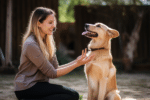Exploring Dog Training: Dog Whisperer Method and Beyond

As explained here, Cesar Millan popularized the Dog Whisperer method. The controversial Dog Whisperer approach and other fascinating dog behavior and training topics will be covered in this essay.
The Dog Whisperer method improves dog-human communication by analyzing dog behavior. Cesar Millan’s methods and concepts attract dog lovers worldwide.
The Dog Whisperer approach developed under prominent figures like Augusto Deoliveira, “The Dog Daddy.” This training method has good and bad reviews in the dog world.
Later, we will address the Dog Whisperer’s controversial aversive training and prong collars. We will address RSPCA concerns about suffering, fear, and irreparable injury.
Not to worry! This post will address objections and propose science-based, reward-based pet well-being and enjoyment remedies. We’ll emphasize consulting expert trainers and veterinary help to rule out medical conditions.
Explore positive reinforcement and science-based dog training in the future. Bonding with your dog and understanding their communication can help you work together.
Responsible dog ownership depends on training. This essay will promote ethical dog ownership and informed decisions that benefit our beloved pets.
Explore the Dog Whisperer method and learn about our pets. Research dog training and make decisions.
The Philosophy Behind the Dog Whisperer Method
Cesar Millan’s Dog Whisperer method has a distinct concept that sets it apart from other training methods. The goal of this strategy is to make the human the pack leader in the dog-human interaction. Trainers use this approach to improve dog behavior and bond with them.
The Dog Whisperer believes dogs are pack animals that thrive in order and leadership. Finding balance and treating troublesome behaviors requires knowing and meeting a dog’s requirements for exercise, punishment, and affection, according to Millan. Trainers use assertive but calm energy to guide and structure dogs’ lives.
The Dog Whisperer method is popular, although its emphasis on dominance and aversiveness has drawn criticism. Some experts say this strategy may not work for many dogs and may cause fear, anxiety, and other problems. We must weigh the pros and disadvantages of the canine Whisperer method and research other training methods that prioritize positive reinforcement and canine welfare as responsible dog owners.

The Importance of Positive Reinforcement
Positive reinforcement is a science-based training technique that focuses on rewarding desired behaviors, rather than punishing undesirable ones. By using rewards such as treats, praise, or play, trainers can motivate and teach dogs to repeat behaviors that are desirable and appropriate.
This approach not only fosters a positive learning experience but also strengthens the bond between dog and owner. Positive reinforcement training promotes trust, confidence, and a cooperative attitude in dogs, leading to long-lasting behavioral changes. Additionally, it encourages dogs to think and problem-solve, resulting in independent decision-making skills and a more positive outlook on training sessions.
By understanding the philosophy behind the Dog Whisperer method and exploring alternative science-based training approaches, dog owners can make informed decisions about the training methods that best suit their dog’s individual needs. The key lies in creating a respectful and loving relationship based on clear communication, patience, and mutual understanding.
Augusto Deoliveira – The Dog Daddy
Augusto Deoliveira, also known as “The Dog Daddy,” has played a significant role in popularizing the Dog Whisperer method. Drawing inspiration from renowned dog trainer Cesar Millan, Deoliveira has developed his own unique approach to understanding and training canines. With his passion for helping dogs and their owners, Deoliveira has gained a loyal following and continues to make a positive impact in the world of canine behavior and training.
Deoliveira’s journey to becoming “The Dog Daddy” began in Brazil, where he discovered his innate ability to connect with dogs and understand their needs. Through years of hands-on experience, he honed his skills and developed a deep understanding of canine behavior. Deoliveira’s approach focuses on establishing trust, respect, and clear communication between humans and dogs.
One of Deoliveira’s key contributions to the Dog Whisperer method is his emphasis on establishing a solid foundation of leadership and boundaries. He believes that by setting clear expectations and providing consistent guidance, dogs can thrive in any environment. The Dog Daddy’s training philosophy aligns with the idea that dogs are pack animals who instinctively seek a strong leader. By assuming this role, Deoliveira helps dog owners establish a harmonious relationship with their four-legged companions.
Deoliveira’s popularity has grown through his YouTube channel, where he shares valuable insights and practical training tips. His approach showcases his genuine care for the well-being of dogs and his desire to educate and empower owners. Through his videos, Deoliveira demonstrates the effectiveness of positive reinforcement, establishing a bond based on trust, and providing dogs with mental and physical stimulation.
Table: Key Principles of Augusto Deoliveira’s Dog Training
| Principle | Description |
|---|---|
| Leadership | Establishing yourself as the pack leader to provide structure and guidance for your dog. |
| Trust and Respect | Building a foundation of trust and respect between you and your dog through consistent and fair interactions. |
| Clear Communication | Using body language, tone of voice, and consistent commands to communicate effectively with your dog. |
| Positive Reinforcement | Rewarding desirable behaviors to encourage their repetition and reinforce the bond with your dog. |
| Mental and Physical Stimulation | Providing ample opportunities for your dog to engage in mental and physical activities to prevent boredom and promote overall well-being. |
Augusto Deoliveira’s commitment to improving the lives of dogs and promoting responsible dog ownership has made him a respected figure in the world of canine behavior and training. While his methods may be controversial to some, his approach focuses on establishing a balance between leadership and love, creating an environment where dogs can thrive. The next section will explore the use of aversive training techniques and equipment in the Dog Whisperer method.
Aversive Training Techniques and Equipment
In the world of canine behavior training, there is a controversial method known as the Dog Whisperer approach. This method, popularized by figures like Cesar Millan and Augusto Deoliveira, utilizes aversive training techniques and equipment such as prong collars. While proponents argue that these methods can effectively correct undesirable behaviors in dogs, critics raise concerns about the potential for pain, fear, and irreversible harm.
The Controversy Surrounding the Dog Whisperer Method
The use of aversive training techniques in the Dog Whisperer method has sparked significant debate within the dog training community. Aversive techniques involve the application of negative consequences, such as physical discomfort or intimidation, to discourage undesirable behaviors. Prong collars, for example, are designed to deliver discomfort and pain when a dog pulls on the leash. However, critics argue that these methods may cause unnecessary stress, fear, and even physical harm to the animal.
Organizations like the RSPCA (Royal Society for the Prevention of Cruelty to Animals) have expressed concerns about the potential welfare implications of aversive training techniques. They argue that positive, reward-based methods are not only more humane but also more effective in fostering a strong bond between dogs and their owners. Advocates for science-based training techniques highlight the benefits of using positive reinforcement, which involves rewarding desired behaviors with treats or praise, instead of resorting to punishment.
The Rise of Positive Reinforcement Training
As the controversy around aversive training techniques grows, many trainers and behaviorists have shifted their focus towards positive reinforcement methods. These science-based approaches prioritize rewarding desired behaviors, encouraging dogs to repeat them. By using treats, toys, and verbal praise, positive reinforcement training seeks to build trust and strengthen the bond between humans and dogs.
Positive reinforcement techniques have been shown to be highly effective in shaping canine behavior and obtaining long-lasting results. They promote dogs’ mental and emotional well-being by creating a positive and rewarding training experience. Additionally, these methods can enhance communication and understanding between dogs and their owners, fostering a relationship built on trust and mutual respect.
| Pros of Aversive Training Techniques | Cons of Aversive Training Techniques |
|---|---|
|
|
Criticisms and Concerns
Despite its popularity, the Dog Whisperer technique has been criticized by several dog behavior and training organizations and people. The RSPCA has criticized this teaching method. They worry about the Dog Whisperer method’s potential for pain, fear, and lasting harm.
The RSPCA recommends positive reinforcement and reward-based training over unpleasant methods and equipment. They feel that using pain or fear to train a dog can harm its health and impair the development of a trusting and pleasant bond with its owner.
Dog owners must recognize and evaluate these critiques and concerns when choosing a training approach for their pets. While the Dog Whisperer method has virtues, we must prioritize our dogs’ welfare and pleasure and seek alternatives that reflect this.
Science-Based, Reward-Based Alternatives
Scientific and reward-based methods that emphasize positive reinforcement and good dog communication are available, but the Dog Whisperer technique is popular. Alternative training methods create trust, strengthen bonds, and encourage desirable actions with rewards and incentives.
Alternatives include clicker training, which employs a small handheld device to mark desired behavior with a click. Pairing the click with a treat or reward helps dogs link the sound with good outcomes, making training more fun and effective.
Another science-based method is “capturing,” where you reward your dog for natural activities you want to reinforce. You can praise or treat your dog for sitting quietly to encourage them to do so again.
Scientific studies have shown that reward-based training methods can lead to better behavior outcomes and stronger bonds between dogs and their owners. By focusing on positive reinforcement, these techniques promote a mutually respectful and enjoyable relationship.
Benefits of Science-Based, Reward-Based Training
When compared to aversive training techniques, science-based, reward-based methods offer several advantages. By avoiding the use of punishment or fear-inducing methods, these techniques create a positive learning environment that fosters trust and cooperation. Additionally, they can help reduce anxiety and stress in dogs, leading to better overall well-being.
| Benefits of Science-Based, Reward-Based Training | Aversive Training Techniques |
|---|---|
| Builds trust and strengthens the bond between dog and owner. | May damage the relationship and create fear or mistrust. |
| Encourages desired behaviors through rewards and incentives. | Relies on punishment or aversive stimuli to suppress unwanted behaviors. |
| Promotes a positive learning environment that reduces anxiety and stress. | Can cause fear, anxiety, and other negative emotional responses. |
By adopting science-based, reward-based training methods, dog owners can create a harmonious and mutually enjoyable relationship with their furry companions. These methods prioritize the dog’s well-being and happiness while still achieving the desired training outcomes.
Seeking Professional Help and Veterinary Support
Professional dog trainers are essential for training your cherished pet. These experts know how to safely and successfully train you. A certified trainer can teach your dog positive reinforcement and reward-based training, which has been scientifically demonstrated to be more effective and kinder.
Veterinary support is essential during your dog’s training, along with expert help. A vet can rule out medical issues impacting your dog’s behavior and health. Medical illnesses like pain or discomfort can cause behavioral issues, thus they must be addressed alongside training.
You may provide your dog complete care by combining expert training and veterinary support. Remember that every dog is different and has different training needs. A experienced trainer and veterinarian can help you create a customized training plan that meets your dog’s demands and protects their physical and mental health.
| Benefits of Seeking Professional Help and Veterinary Support | Why it Matters |
|---|---|
| 1. Expert Guidance | Ensures you follow effective training techniques and methods tailored to your dog’s needs. |
| 2. Safety and Welfare | Reduces the risk of unintentional harm and ensures your dog’s well-being throughout the training process. |
| 3. Holistic Approach | Addresses any underlying health concerns that may contribute to your dog’s behavioral issues. |
| 4. Long-Term Success | Provides you with the tools and knowledge to maintain your dog’s training and behavior in the future. |
Remember, as a responsible dog owner, it is your duty to prioritize the well-being and happiness of your four-legged friend. Seeking professional help from qualified trainers and obtaining veterinary support not only ensures the effectiveness of the training but also promotes a positive and nurturing training environment for your dog. By investing in their training and care, you are fostering a strong bond with your canine companion and setting them up for a lifetime of happiness and well-being.
Controversial Seminars by The Dog Daddy
In recent months, controversial seminars conducted by Augusto Deoliveira, also known as “The Dog Daddy,” have sparked public concerns and drawn the attention of organizations such as the RSPCA. These seminars, centered around the Dog Whisperer method, have been criticized for their questionable training techniques and their potential impact on canine behavior and well-being.
During these seminars, Deoliveira promotes the use of aversive training methods and equipment, including prong collars. These techniques, although controversial, have gained popularity among some dog owners seeking quick results. However, they have been met with significant backlash from organizations and experts advocating for more humane, science-based training approaches.
The RSPCA, in particular, has voiced concerns over the potential harm caused by these seminars. The organization emphasizes the adverse effects of aversive training techniques, which can induce fear and pain in dogs, leading to long-term behavioral issues and even irreversible harm. Their call for information regarding the undisclosed locations of Deoliveira’s seminars highlights their commitment to protecting the welfare of animals and raising awareness about responsible training practices.
| Key Points: | Public Concerns |
|---|---|
| Controversial seminars conducted by Augusto Deoliveira | Organizations like the RSPCA raising concerns |
| Promotion of aversive training techniques and equipment | Potential for fear, pain, and irreversible harm |
| RSPCA’s appeal for information on undisclosed seminar locations | Commitment to welfare and responsible training practices |
RSPCA’s Call for Information
The RSPCA has lately requested information about Dog Daddy’s seminar venues. RSPCA wants more information to analyze the welfare effects of these workshops. The RSPCA wants to protect dogs at these events and reveal their training practices by asking the public for information.
To report the secret places where Dog Daddy holds seminars, contact the RSPCA via their helpline or online reporting site. Your help is needed to help the RSPCA investigate and resolve animal welfare issues related to these events. Since the RSPCA values whistleblowers, your identity will be kept anonymous.
You may help protect dogs and promote appropriate dog training by giving information.
Together, we can ensure that training methods align with the well-being and happiness of our canine companions.
Enhancing the Bond with Your Dog
Building a strong bond with your dog is essential for a harmonious and fulfilling relationship. Understanding canine behavior and communication can greatly enhance this bond, allowing you to connect with your furry companion on a deeper level. By incorporating effective training techniques and promoting open communication, you can create a strong foundation of trust and mutual understanding with your dog.
Dogs are social animals, and they thrive on companionship and interaction. Spending quality time with your dog, engaging in activities that they enjoy, and providing mental and physical stimulation are essential for fostering a strong bond. This can include daily walks, playtime, and interactive training sessions that encourage their natural instincts and abilities.
Communication is key in any relationship, and the same applies to your bond with your dog. Learning to understand and interpret their body language, vocalizations, and subtle cues can help you respond appropriately to their needs and emotions. This can ultimately strengthen the trust and connection between you and your furry friend.
| Benefits of Bonding with Your Dog |
|---|
| 1. Increased obedience and responsiveness to commands |
| 2. Reduced behavioral issues and anxiety |
| 3. Enhanced overall well-being and happiness |
| 4. Improved ability to address training challenges |
| 5. Strengthened sense of loyalty and companionship |
Remember, building a bond with your dog takes time, patience, and consistency. It’s important to approach training and communication with a positive and reward-based mindset, avoiding harsh or aversive techniques that can damage the trust between you and your furry friend. By prioritizing their well-being and understanding their individual needs, you can create a strong and lasting bond that will enrich both of your lives.
The Future of Canine Training
As the field of canine training continues to evolve, there is a growing shift towards positive reinforcement and science-based techniques. Dog owners are recognizing the importance of building a strong bond with their four-legged companions, fostering communication, and prioritizing their well-being. The future of canine training lies in understanding the principles of positive reinforcement and using scientifically proven methods to shape desirable behaviors.
Positive reinforcement involves rewarding a dog for desirable behaviors, such as sitting or coming when called, with treats, praise, or toys. This approach focuses on teaching dogs what we want them to do rather than punishing them for unwanted behaviors. By rewarding positive behaviors, we encourage dogs to repeat them, creating a positive learning experience. Science-based training techniques are grounded in research and principles of animal behavior, ensuring effective and humane training methods.
Scientific studies have shown that positive reinforcement is not only more effective but also leads to happier and more well-adjusted dogs. Dogs trained using positive methods are more likely to exhibit increased confidence, reduced fear and aggression, and improved overall behavior. This approach also strengthens the bond between the dog and their owner, fostering trust and cooperation.
| Benefits of Positive Reinforcement Training | Dog Whisperer Method |
|---|---|
| Creates a positive learning experience | Relies on aversive techniques |
| Reduces fear and aggression | May increase fear and anxiety |
| Strengthens the bond between dog and owner | Focuses less on the human-canine bond |
| Promotes long-term behavior change | Can lead to temporary compliance |
As we look to the future, it is crucial for dog owners to educate themselves on the various training methods available and make informed choices based on the well-being of their furry friends. By embracing positive reinforcement and science-based techniques, we can enhance the lives of our dogs and strengthen the bond we share with them.
The Importance of Responsible Dog Ownership
Responsible dog ownership goes beyond providing food, shelter, and veterinary care for our furry companions. It also encompasses the way we train and interact with them. By understanding the principles of responsible dog ownership, we can ensure a harmonious and fulfilling relationship with our canine friends.
“Owning a dog is not just a privilege, it’s a responsibility. It’s our duty to ensure their physical and emotional well-being,”
Training plays a crucial role in responsible dog ownership. Rather than resorting to aversive techniques or punishment-based methods, it is important to focus on positive reinforcement training. This approach not only helps in teaching our dogs the desired behaviors but also fosters a strong bond built on trust and respect.
- Provide proper training and socialization to address behavioral issues and ensure your dog’s safety.
- Follow local leash laws and always pick up after your dog to maintain cleanliness in public spaces.
- Spay or neuter your dog to prevent unwanted litters and contribute to population control.
- Keep your dog’s vaccinations up to date and schedule regular veterinary check-ups to ensure their health and well-being.

The table below highlights the key aspects of responsible dog ownership:
| Responsibilities | Description |
|---|---|
| Training | Positive reinforcement training techniques to shape desired behaviors. |
| Exercise & Mental Stimulation | Providing daily physical exercise and engaging activities to keep your dog mentally stimulated. |
| Nutrition | Feeding a balanced and nutritious diet appropriate for your dog’s age, size, and health needs. |
| Grooming & Hygiene | Regular grooming sessions to maintain your dog’s hygiene and overall cleanliness. |
| Healthcare | Scheduling regular veterinary check-ups, vaccinations, and preventive care. |
| Socialization | Exposing your dog to various environments, people, and other animals to develop good social skills. |
| Safety & Exercise | Always keeping your dog on a leash in public areas and providing a secure environment at home. |
| Respect & Love | Showing respect, love, and care for your dog by providing attention, affection, and companionship. |
Conclusion
In conclusion, Augusto Deoliveira’s Dog Whisperer method has fascinated and divided dog behavior trainers. This strategy stresses communication and leadership to build a deep bond with your dog, although unpleasant training methods and equipment raise issues.
The RSPCA is concerned about the Dog Whisperer method’s potential for pain, fear, and lasting harm. Alternatives include science-based and reward-based training that uses positive reinforcement to enhance dog behavior.
If you need professional dog training, find a trained and licensed trainer that cares about your pet. Veterinary help should also be sought to rule out medical causes of behavioral disorders.
As responsible dog owners, we must make informed training decisions. Understanding the importance of bonding and talking with dogs can lead to a trusting and harmonious relationship.
FAQ
What is the Dog Whisperer Method?
The Dog Whisperer Method is a controversial training technique used by a dog trainer named Augusto Deoliveira, also known as “The Dog Daddy.” It involves using aversive training techniques and equipment, such as prong collars, to stop dangerous behaviors in dogs.
Why is the Dog Whisperer Method controversial?
The Dog Whisperer Method is controversial because it uses aversive training techniques that can cause pain and fear in dogs, potentially leading to irreversible harm. The RSPCA advises against these methods and recommends seeking help from a qualified, certified trainer who uses science-based, reward-based methods.
Should I attend The Dog Daddy’s seminars in the UK?
The RSPCA has raised concerns about the upcoming seminars by The Dog Daddy, as these sessions are held in secretive locations. They urge the public to provide information about these locations to ensure the well-being of dogs involved.
What are the alternatives to the Dog Whisperer Method?
Science-based, reward-based methods are recommended as alternatives to the Dog Whisperer Method. These methods focus on positive reinforcement and effective communication to train dogs without causing pain or fear.
How can I seek professional help for my dog’s behavior?
If you need help with your dog’s behavior, it is advised to seek assistance from a qualified, certified trainer who utilizes positive training techniques. Additionally, consulting a veterinarian is recommended to rule out any underlying medical conditions that may be contributing to the behavior.
Why is the RSPCA concerned about the Dog Daddy’s seminars?
The RSPCA has concerns about the Dog Daddy’s seminars due to the use of aversive training techniques and equipment. They believe that these methods can be harmful to dogs and are urging the public to provide information about the secretive locations of these sessions.
How can I enhance the bond with my dog?
By utilizing positive training techniques, spending quality time with your dog, providing mental and physical enrichment, and practicing effective communication, you can enhance the bond with your dog and strengthen your relationship.
What is the future of canine training?
The future of canine training lies in positive reinforcement and science-based methods. These approaches prioritize the well-being and mental health of dogs, ensuring effective training without the use of aversive techniques.
What is the importance of responsible dog ownership?
Responsible dog ownership involves providing proper care, training, and socialization to ensure the well-being and safety of your dog and the community. It is essential to understand your dog’s needs, behavior, and any potential challenges they may face.






